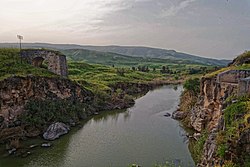| Yarmuk | |
|---|---|
 Yarmuk River near the Naharayim/Baqura Area | |
| Native name | |
| Location | |
| Country | Syria, Jordan, Israel |
| Region | Middle East, Eastern Mediterranean littoral |
| Physical characteristics | |
| Source | |
| • location | Hauran |
| Mouth | Jordan River |
• location | Naharayim/Baqura Area Israel/Jordan |
• coordinates | 32°38′39″N 35°34′22″E / 32.64417°N 35.57278°E |
| Length | Approx. 70 km (43 mi) |
| Basin size | Approx. 7,000 km2 (2,700 sq mi) |
| Discharge | |
| • average | 14.5 m3/s (510 cu ft/s) |
| Basin features | |
| Tributaries | |
| • left | Ruqqad, 'Allan |
| • right | Ehreir, Zeizun |
The Yarmuk River (Arabic: نهر اليرموك, romanized: Nahr al-Yarmūk, Hebrew: נְהַר הַיַּרְמוּךְ, romanized: Nəhar hayYarmūḵ; Greek: Ἱερομύκης, Hieromýkēs; Latin: Hieromyces[1] or Heromicas;[2] sometimes spelled Yarmouk)[3] is the largest tributary of the Jordan River.[4] It runs in Jordan, Syria and Israel, and drains much of the Hauran plateau. Its main tributaries are the wadis of 'Allan and Ruqqad from the north, Ehreir and Zeizun from the east. Although the Yarmuk is narrow and shallow throughout its course, at its mouth it is nearly as wide as the Jordan, measuring thirty feet in breadth and five in depth. The once celebrated Matthew Bridge used to cross the Yarmuk at its confluence with the Jordan.[5]
- ^ Meyers, E. M.; Brown, J. P. (October 27, 2017). "Hieromyces (river): a Pleiades place resource". Pleiades: a gazetteer of past places.
- ^ "TM Places". www.trismegistos.org.
- ^ Schürer, Emil (2014-01-30). The History of the Jewish People in the Age of Jesus Christ. A&C Black. page 133, note 243. ISBN 9781472558299. Retrieved 2021-04-07.
- ^ It is one of three main tributaries which enter the Jordan between the Sea of Galilee and the Dead Sea; to the south there are the Zarqa (Jabbok) and the Mujib (Arnon) rivers.
- ^ "YARMUK - JewishEncyclopedia.com". jewishencyclopedia.com.